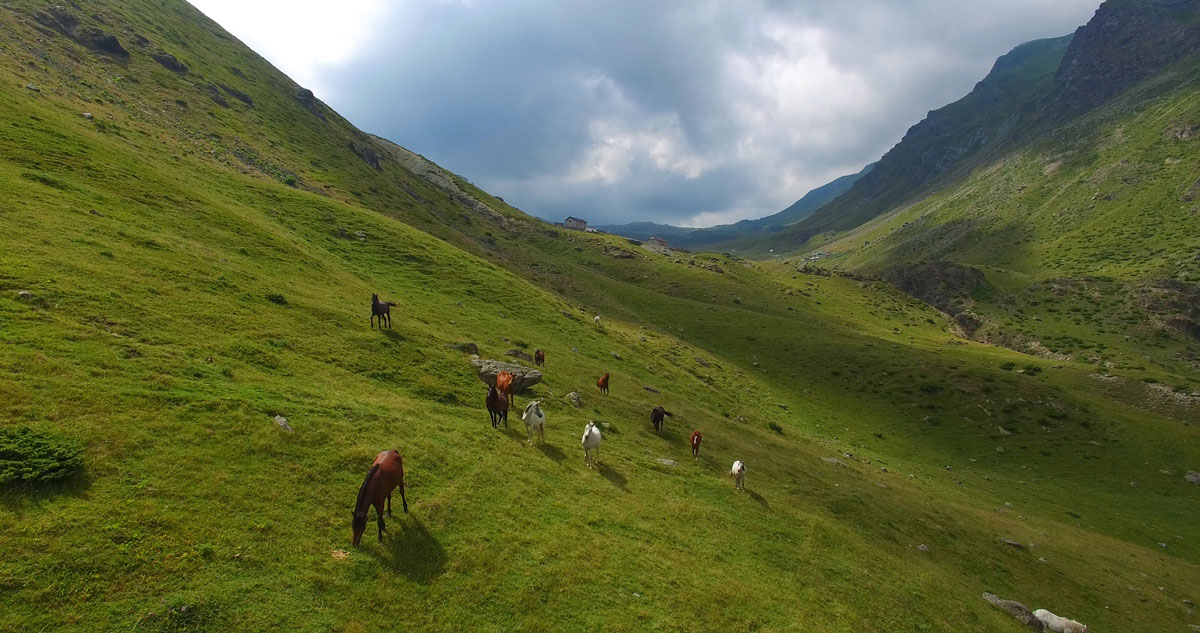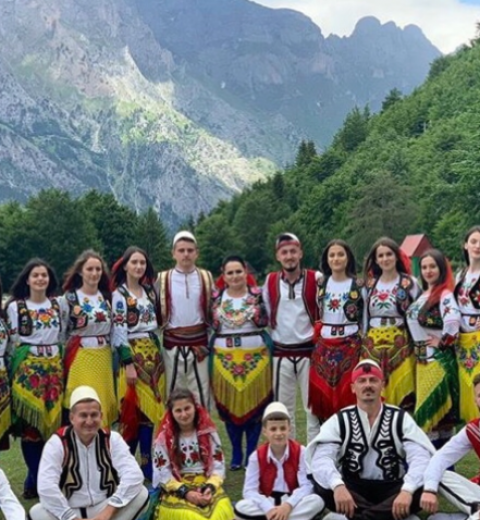Tropoja as a territory includes the regions of Old Tropoja, Margegaj, Lekbibaj, Bujan, city of Bajram Curri, Fierza, Llugaj and Bytyq. Tropoja is part of the Gjakova Mountains. Tropoja is the most northeastern district of the Homeland .
* A special feature for Tropoja Mountains is that the lack of education, the mountaineers have solved or compensated through the “Men’s Stove”, or otherwise “Men’s Chamber” or as they have called it “Mountain Chamber”.
* Mountain Chamber was a school, it was a university, where the men of the tribe met, from the wider region and through conversations and debates, opinions were expressed and the problems that were dictated by time were solved.
* It performed many functions. Generosity, manliness, hospitality, faith, patriotism, etc.
* Tribe in our Mountains is a social organization developed and maintained mainly on the basis of blood brotherhood, the result of the historical development of the old Albanian family with a special organization of internal self-government and a certain territory, which has been expanding to the extent that in recent centuries, by branching out into many fraternities, it has created and included entire provinces and villages.
City of Bajram Curri is the administrative centre of Tropoja situated just below the Chestnut massive as one of the biggest in Albania.
The city was build where once was the village of Kolegecaj soon after the World War Two. Before that time the administrative centre of Tropoja was the city of Gjakova now in Kosovo. The city bears the name of the national hero, BAJRAM CURRI, who as a memorial has a statue in the heart of the city.
Tropoja tribes:
1- Gashi tribe(Gashi is one of the oldest inhabited tribes in the province of Tropoja and has a wide spread, not only in Albania, but also in Kosovo and Montenegro. The geographical position of this tribe is one of the most preferable and favorable than in other tribes. All its territory as soon as the sun rises, is covered with the first rays of the morning.)
2-Krasniqe tribe (Krasniqi is the largest tribe in Tropoja in terms of area and population.The name Krasniq is derived from the first of this tribe Kraha)
3- Bytyç tribe(The Bytyc tribe occupy the southeastern part of the province of Tropoja. Some villages of Bytycit are inhabited very early.)
4-Nikaj tribe(Nikaj is an integral part of the Krasniqe tribe, has the same origin and are of the same blood)
5-Mertur tribe(The Mertur tribe is Berisha and comes from the Dukagjini Princely Family)
6- Berishe tribe
7-Shipshan Tribe
8- Hot tribe
9-Kelmend tribe
10- Vuthaj tribe
11- Shale tribe
History:
The villages across the region known as Tropoja where historically linked to a wider area of population which shared common historical and cultural features known as Dardani.
Traces of this group of inhabitants can be found since neolithic age.
One of the oldest settlements from the 4th century BC, traces of which can be seen to nowadays, belong to the fortress of Rosuja which used to be an inhabited centre situated on the border between important local tribes of Labeat and Dardani.
Another important castle in the area is found in the village of Geghysen, which dates back to the 15th century and sheds light on the local customs of Arberi population (medieval Albanians) during this period. Important feudal families such as Pjeter Shpani would have this area as their dominion, which at that time was part of Dukagjini Principality. So for example we read from priests such as Frang Bardhi 1636 that he visited the castle and the local church during his journeys from across Northern Albania.
Valbona river took its name around the 17th century during a period of time when there was a desperate need from the local population to maintain theiur cultural and religious values in a period of time when the Ottomans were converting many local people to islam. So the name derived from an Italian priest who used to minister in the area and came from an area in Italy with the same name: Val Buona.
Rosuja Tropoje
Situated near the village of Bujan, Rosuja was an important illyrian centre dating since the 4th century BC. Archeological excavation in the area yielded materials that date back from the 5th century bc up to the 4-6 century AD.
Rosuja is part of the Krasniqe tribe. It is bordered on the east by the village of Dojan, on the north-east by Markaj, on the west by Llozha i Grise and on the south by the Grazhdenica stream and Tuçep.
Rosuja is an Illyrian fortified town, located about 6 km southwest of the city of Bajram Curri. It rises on the ridge of two rocky swamps between the Grazhdenica stream in the east and the Gashi stream in the west. Archaeological research shows that this center was inhabited since the beginning of the Second Millennium BC and continued until the 5th century AD …
Rosuja is populated by two brothers: that of Margjekaj and Dozhlani.
Dozhlani is not a human name, nor a place name, but as the dozhlans themselves explain, one of the first after he was born crippled and his relatives called him “dozhlan”, with physical defects, as a result the word dozhlan remained for the surname of this fraternity.
Rosuja is an important craft-commercial and administrative center of the province. Various discoveries such as: The coins of Shkodra, Durres and Apollonia show the trade relations of this province with other Illyrian cities.
Archaeological Map of Tropoja
ROSUJA
Archaeological excavations carried out in Rosuja during the years 1964-1965 have given a lot of evidence on the history of the birth and development of this town. Rich archaeological material discovered here such as: stone tools, utensils and other clay objects, work tools and iron weapons, ornaments and gold and silver coins, etc. showed that this center was formerly inhabited since the end of the second millennium BC, and continued to be inhabited until the century. of V of our era.
TUMAT E BUJANIT
On the left bank of the Valbona River, on a terrace of the Red Apple neighborhood of the village of Bujan, in 1982 several mounds (small hills where burials were performed) were discovered. Archaeological excavations carried out in 1984 revealed that these mounds belong to the Early Iron Age, about 3,000 years ago.
SHOSHAN CASTLEWhere the Dragobi gorge begins, on the left side of the river Valbona, on a strong rock that falls sharply about 60 m. above the river, there are ruins of a fortified settlement of the Roman period, c. I – V of our era, known as the Castle of Shoshan. This castle has served as a strategic defensive point of the Malësia Valley on the side of the Dragobia Gorge and is simultaneous with the fortifications made to the town of Rosuja during the Roman period.
KOMI
To the right of the Tropoja River, where the Sylbika Gorge begins, rises a mountain massif about 1700 m. high called Mount Kom. In a small plain at its foot fragments of walls and traces of a road about 2 m were discovered. wide that connected the Tropoja Valley with the mountains of Sylbica, Dobërdol, Koshotica, to continue further in Theth and Kosovo. Like the fortified settlement of Shoshan, Komi has served as a strategic point for the protection of the Tropoja Valley from attacks coming through the river mouth.
Cerrnica
It has long been rumored about Cerrnica that “once upon a time there existed a city with so many dwellings that a cat could cross from roof to roof from Dizdari to Bega
BERISHA
Another archeological point of the Tropoja district is the village of Berisha in the province of Bytyç.
There, on a small hill in the course of the Çuni stream, between the neighborhoods of Rodogosht and Rushtë-Shëngjergj, 3-4 km. to the right of the Drin River, the ruins of a medieval castle are preserved.
The fragments of the surrounding walls, which look especially on the south side, are worked with broken stones and lime mortar. Medieval pottery and pottery have been found near them.
TROPOJA AS THE CANDLE OF CULTURE
Tropoja stands out differently as the cradle of culture. The diversity of cultures, customs and traditions are these features that enrich Tropoja the most.
In Tropoja you can find a very rich culture with songs, dances and colorful costumes, popular games and various sports.
Costumes
Tropoja has inherited culture and is born and generates culture. The Gjakova Mountains are rich in folk costumes. Some of them have very ancient origins, such as the dress of Nikaj Mertur’s women, the dress with white and black t-shirts, the vest or glass embroidered with black braids for men, the tight dress and wide dress for other women. Folk costumes are the essential element, the hallmark of a nation.
Songs
Tropoja also differs for variety of songs. Some of the traditional folk songs are:
1 ~ Kreshnikesh songs (songs accompanied by lahute. They are epic war songs and are interpreted with longing, special pain and pride and are experienced as such by those who listen to them.
2 ~ Songs of heroes (usually sung to prominent individuals who have done bravery
3 ~ Songs at the top of the wing or asqerce (Usually sung by two men together, putting their fingers in their ears and shouting loudly.
4 “Vargca” songs (sung by men accompanied by cifteli, are usually songs of bravery but also love.
5 ~ Girls songs (Sung by girls themselves, can be: tray songs, wedding songs, cradle songs, mourning songs, etc.
Dances
Dances are companions in the long journey of history and an integral part of the spiritual life of the people of this region, they are a deserved part of our national culture.
CURIOSITY
According to the Tropojans before, there were some rules for going to the mountains. There was no fixed date for going to the mountains. When people started going to the mountains there was no calendar, no one knew who was writing or singing, they were headed by the Moon (new moon or old moon)…. The day of going to the mountains was set according to a rule: The second Monday of the month June of each year, whenever that day of “probable ascent” falls. This definition had its reason. This period is enough for all the mountains so that the grass, the oak leaf has reached the proper ripening so as not to poison or damage the cattle.
The community of Tropoja has new innovations in the social movement, such as GLOW and Scout. It is worth mentioning that Albania is one of the 5 countries without scouts and now this opportunity came to Tropoja, to become the first Scouts os Via Dinarica group in Albania. Glow is a safe space for all the girls of Tropoja to show what are they capable of.Its an organization that helps the girls to learn new things and motivates them that with work and will they can achieve their goals.GLOW~Girls Leading Our World. Scout is a social movement that unites the youth of a community to take action in the development of the country where they live. In Tropoja it started as a new tradition in collaboration with Glow and turned out to be very successful.




